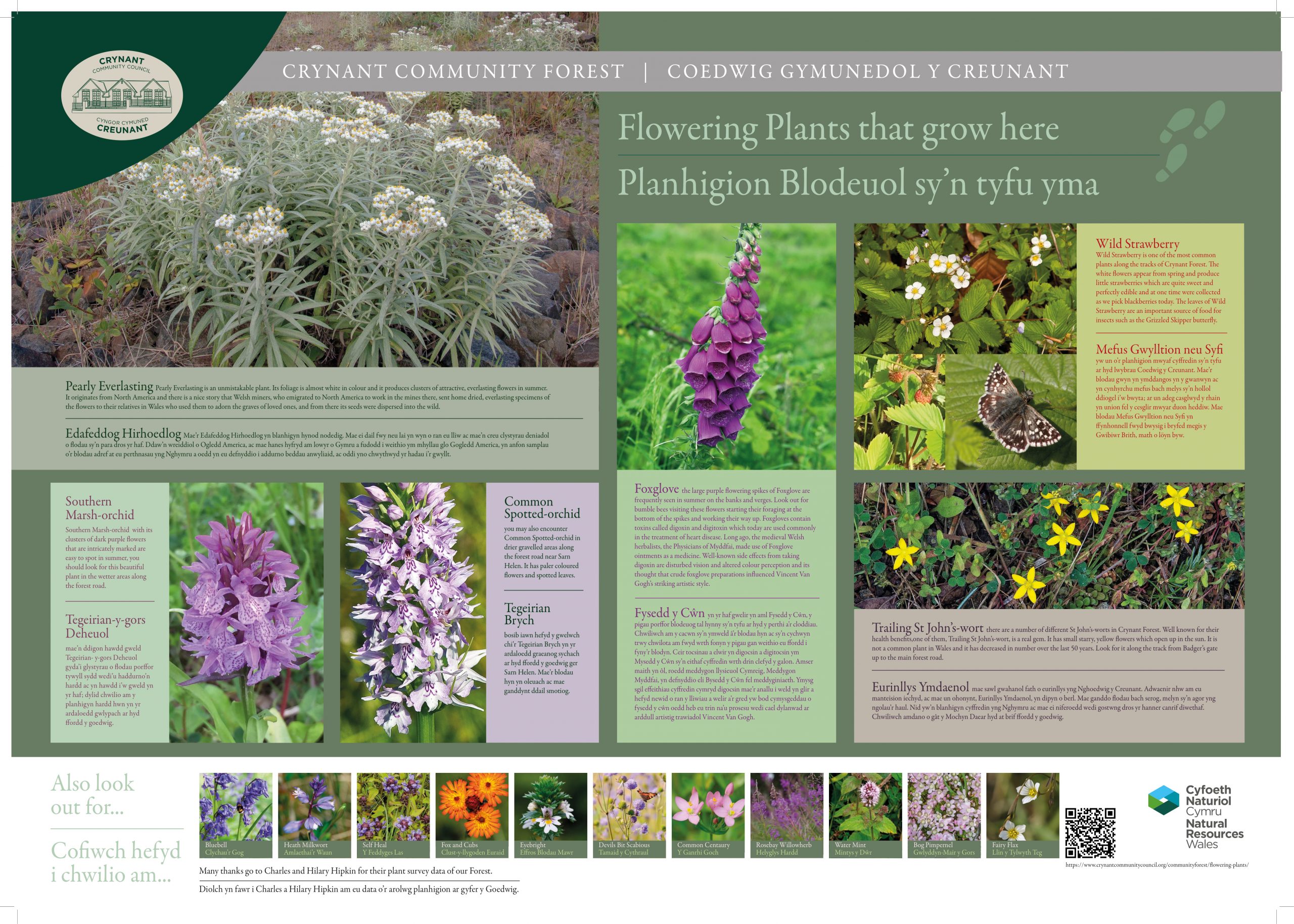Planhigion Blodeuol sy’n tyfu yma.
This is just a small selection of the flora that you’ll find along your walking routes. We’d also advise that you look out for:
Bluebell – (Clychau’r Gog),
Heath Milkwort – (Amlaethai’r Waun),
Self Heal – (Y Feddyges Las),
Fox and Cubs – (Clust-y-llygoden Euraid),
Eyebright – (Effros Blodau Mawr),
Devils Bit Scabious – (Tamaid y Cythraul),
Common Centaury – (Y Ganrhi Goch),
Rosebay Willowherb – (Helyglys Hardd),
Water Mint – (Mintys y Dŵr),
Bog Pimpernel – (Gwlyddyn-Mair y Gors),
Fairy Flax – (Llin y Tylwyth Teg).
With such a wide variety of flora in the area, we would also like to remind our walkers of a few points in the countryside code which is available at the NRW site here.
We all have a responsibility to protect the countryside now and for future generations, so make sure you don’t harm animals, birds, plants or trees and try to leave no trace of your visit. Protecting the natural environment means taking special care not to damage, destroy or remove features such as rocks, plants and trees. They provide homes and food for wildlife, and add to everybody’s enjoyment of the countryside.
For those of our walkers who are using a screen-reader to help them access the information on the panels, our text in readable format is below in Welsh and English:
Pearly Everlasting Pearly Everlasting is an unmistakable plant. Its foliage is almost white in colour and it produces clusters of attractive, everlasting flowers in summer. It originates from North America and there is a nice story that Welsh miners, who emigrated to North America to work in the mines there, sent home dried, everlasting specimens of the flowers to their relatives in Wales who used them to adorn the graves of loved ones, and from there its seeds were dispersed into the wild.
Southern Marsh-orchid Southern Marsh-orchid with its clusters of dark purple flowers that are intricately marked are easy to spot in summer, you should look for this beautiful plant in the wetter areas along the forest road.
Marsh-orchid Southern Marsh-orchid with its clusters of dark purple flowers that are intricately marked are easy to spot in summer, you should look for this beautiful plant in the wetter areas along the forest road.
Foxglove the large purple flowering spikes of Foxglove are frequently seen in summer on the banks and verges. Look out for bumble bees visiting these flowers starting their foraging at the bottom of the spikes and working their way up. Foxgloves contain toxins called digoxin and digitoxin which today are used commonly in the treatment of heart disease. Long ago, the medieval Welsh herbalists, the Physicians of Myddfai, made use of Foxglove ointments as a medicine. Well-known side effects from taking digoxin are disturbed vision and altered colour perception and its thought that crude foxglove preparations influenced Vincent Van Gogh’s striking artistic style.
Wild Strawberry is one of the most common plants along the tracks of Crynant Forest. The white flowers appear from spring and produce little strawberries which are quite sweet and perfectly edible and at one time were collected as we pick blackberries today. The leaves of Wild Strawberry are an important source of food for insects such as the Grizzled Skipper butterfly.
Trailing St John’s-wort, there are a number of different St John’s-worts in Crynant Forest. Well known for their health benefits, one of them, Trailing St John’s-wort, is a real gem. It has small starry, yellow flowers which open up in the sun. It is not a common plant in Wales and it has decreased in number over the last 50 years. Look for it along the track from Badger’s gate up to the main forest road.
Common Spotted-orchid you may also encounter Common Spotted-orchid in drier gravelled areas along the forest road near Sarn Helen. It has paler coloured flowers and spotted leaves.
——————————————————————————————————————-
Edafeddog Hirhoedlog Mae’r Edafeddog Hirhoedlog yn blanhigyn hynod nodedig. Mae ei dail fwy neu lai yn wyn o ran eu lliw ac mae’n creu clystyrau deniadol o flodau sy’n para dros yr haf. Ddaw’n wreiddiol o Ogledd America, ac mae hanes hyfryd am lowyr o Gymru a fudodd i weithio ym mhyllau glo Gogledd America, yn anfon samplau o’r blodau adref at eu perthnasau yng Nghymru a oedd yn eu defnyddio i addurno beddau anwyliaid, ac oddi yno chwythwyd yr hadau i’r gwyllt.
Tegeirian-y-gors Deheuol mae’n ddigon hawdd gweld Tegeirian- y-gors Deheuol gyda’i glystyrau o flodau porffor tywyll sydd wedi’u haddurno’n hardd ac yn hawdd i’w gweld yn yr haf; dylid chwilio am y planhigyn hardd hwn yn yr ardaloedd gwlypach ar hyd ffordd y goedwig.
Tegeirian-y-gors Deheuol mae’n ddigon hawdd gweld Tegeirian- y-gors Deheuol gyda’i glystyrau o flodau porffor tywyll sydd wedi’u haddurno’n hardd ac yn hawdd i’w gweld yn yr haf; dylid chwilio am y planhigyn hardd hwn yn yr ardaloedd gwlypach ar hyd ffordd y goedwig.
Tegeirian Brych bosib iawn hefyd y gwelwch chi’r Tegeirian Brych yn yr ardaloedd graeanog sychach ar hyd ffordd y goedwig ger Sarn Helen. Mae’r blodau hyn yn oleuach ac mae ganddynt ddail smotiog.
Fysedd y Cŵn yn yr haf gwelir yn aml Fysedd y Cŵn, y pigau porffor blodeuog tal hynny sy’n tyfu ar hyd y perthi a’r cloddiau. Chwiliwch am y cacwn sy’n ymweld â’r blodau hyn ac sy’n cychwyn trwy chwilota am fwyd wrth fonyn y pigau gan weithio eu ffordd i fyny’r blodyn. Ceir tocsinau a elwir yn digocsin a digitocsin ym Mysedd y Cŵn sy’n eithaf cyffredin wrth drin clefyd y galon. Amser maith yn ôl, roedd meddygon llysieuol Cymreig, Meddygon Myddfai, yn defnyddio eli Bysedd y Cŵn fel meddyginiaeth. Ymysg sgil effeithiau cyffredin cymryd digocsin mae’r anallu i weld yn glir a hefyd newid o ran y lliwiau a welir a’r gred yw bod cymysgeddau o fysedd y cŵn oedd heb eu trin na’u prosesu wedi cael dylanwad ar arddull artistig trawiadol Vincent Van Gogh.
Mefus Gwylltion neu Syfi yw un o’r planhigion mwyaf cyffredin sy’n tyfu ar hyd lwybrau Coedwig y Creunant. Mae’r blodau gwyn yn ymddangos yn y gwanwyn ac yn cynhyrchu mefus bach melys sy’n hollol ddiogel i’w bwyta; ar un adeg casglwyd y rhain yn union fel y cesglir mwyar duon heddiw. Mae blodau Mefus Gwylltion neu Syfi yn ffynhonnell fwyd bwysig i bryfed megis y Gwibiwr Brith, math o löyn byw.
Eurinllys Ymdaenol mae sawl gwahanol fath o eurinllys yng Nghoedwig y Creunant. Adwaenir nhw am eu manteision iechyd, ac mae un ohonynt, Eurinllys Ymdaenol, yn dipyn o berl. Mae ganddo flodau bach serog, melyn sy’n agor yng ngolau’r haul. Nid yw’n blanhigyn cyffredin yng Nghymru ac mae ei niferoedd wedi gostwng dros yr hanner canrif diwethaf. Chwiliwch amdano o gât y Mochyn Daear hyd at brif ffordd y goedwig.

